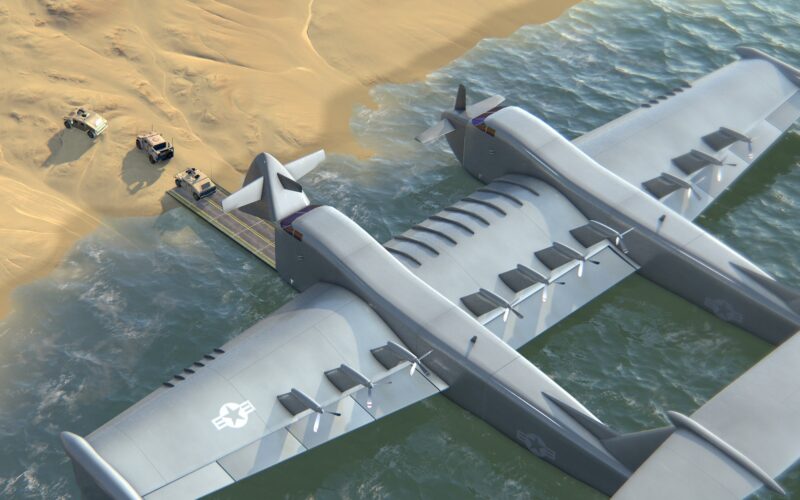DARPA has selected General Atomics and Boeing’s Aurora to develop designs for the Liberty Lifter ground effect transport seaplane program.
The Liberty Lifter is designed to be a ‘long-range, low-cost X-Plane capable of seaborne strategic and tactical heavy lift’.
“We are excited to kick off this program and look forward to working closely with both performer teams as they mature their point-of-departure design concepts through Phase 1,” DARPA Liberty Lifter Program Manager Christopher Kent said in a statement. “The two teams have taken distinctly different design approaches that will enable us to explore a relatively large design space during Phase 1.”
The industrial team, led by General Atomics, chose a twin-hull reminiscent of the Stratolauch built by Scaled Composites to carry air-launch-to-orbit rockets, plus a mid-wing. According to DARPA, this design optimizes on-water stability and seakeeping performance. Twelve turboshaft engines will power the aircraft.
As for Aurora Flight Sciences, the design resembles a more traditional seaplane design with a singular hull, a high wing and eight turboprops for propulsion. This design is close to the Boeing Pelican ULTRA imagined by Aurora’s parent company in the early 2000s.
What is the Liberty Lifter?
Much like the Soviet-era ekranoplans, the Liberty Lifter will be able to take advantage of the ‘ground effect’, which results in an increase in lift and a decrease in drag when an aircraft flies at very low altitude, making it capable of highly controlled flight close to turbulent water surfaces. This type of flight also keeps the aircraft below radar coverage for stealth-like insertion into a contested environment.
But unlike the ekranoplans, the aircraft envisioned by DARPA will also be capable of sustained flight at mid-altitudes and thus will not be restricted to calm waters. It will be similar in size and capacity to the C-17 Globemaster III transport aircraft, carrying over 100 tons of cargo.
Such an aircraft would be particularly useful in Southeast Asia. The region, notably the South China Sea, is a site of constant geopolitical tensions between China and neighboring countries, many of them supported by the US.
“New classes of Navy and Marine Corps WIG [wing-in-ground-effect – ed. Note] craft could dramatically increase the intratheater mobility of expeditionary forces in the Pacific and improve resupply from the United States and allies,” explained Joshua Taylor, the Chief of South Asia Division of US Indo-Pacific Command, for the US Naval Institute. “While not invulnerable, WIG craft offset many of China’s anti-access/area-denial (A2AD) investments.”
The capabilities of the Liberty Lifter would negate the need for maritime transport, which is slow and vulnerable to threats such as submarines, or for traditional airlifters that require an operable runway and are detectable by radars or real-time satellites.

